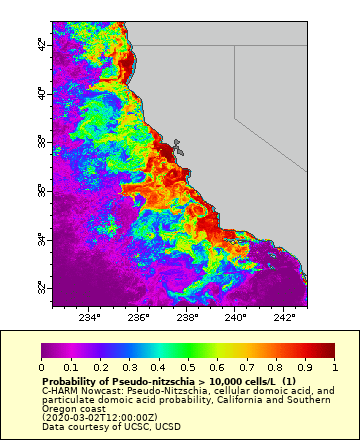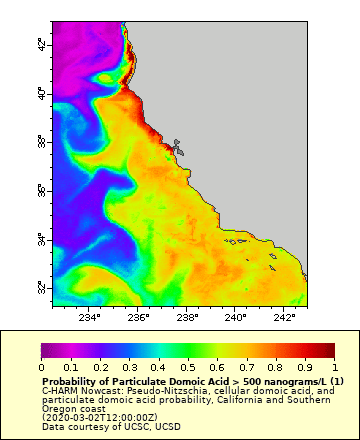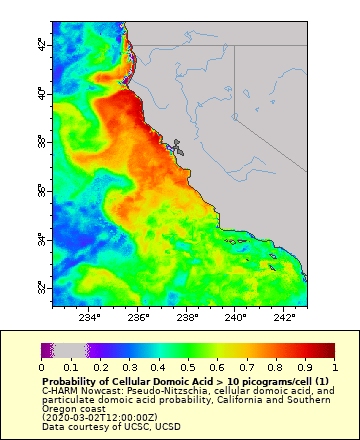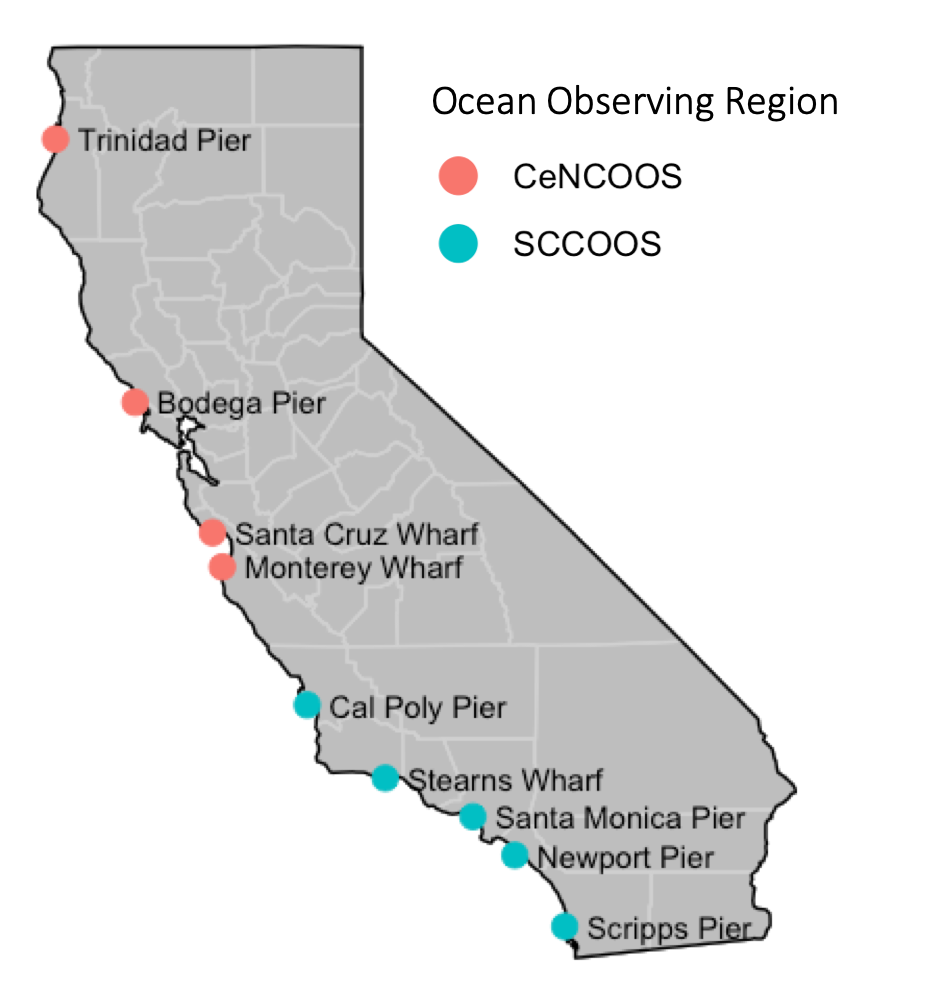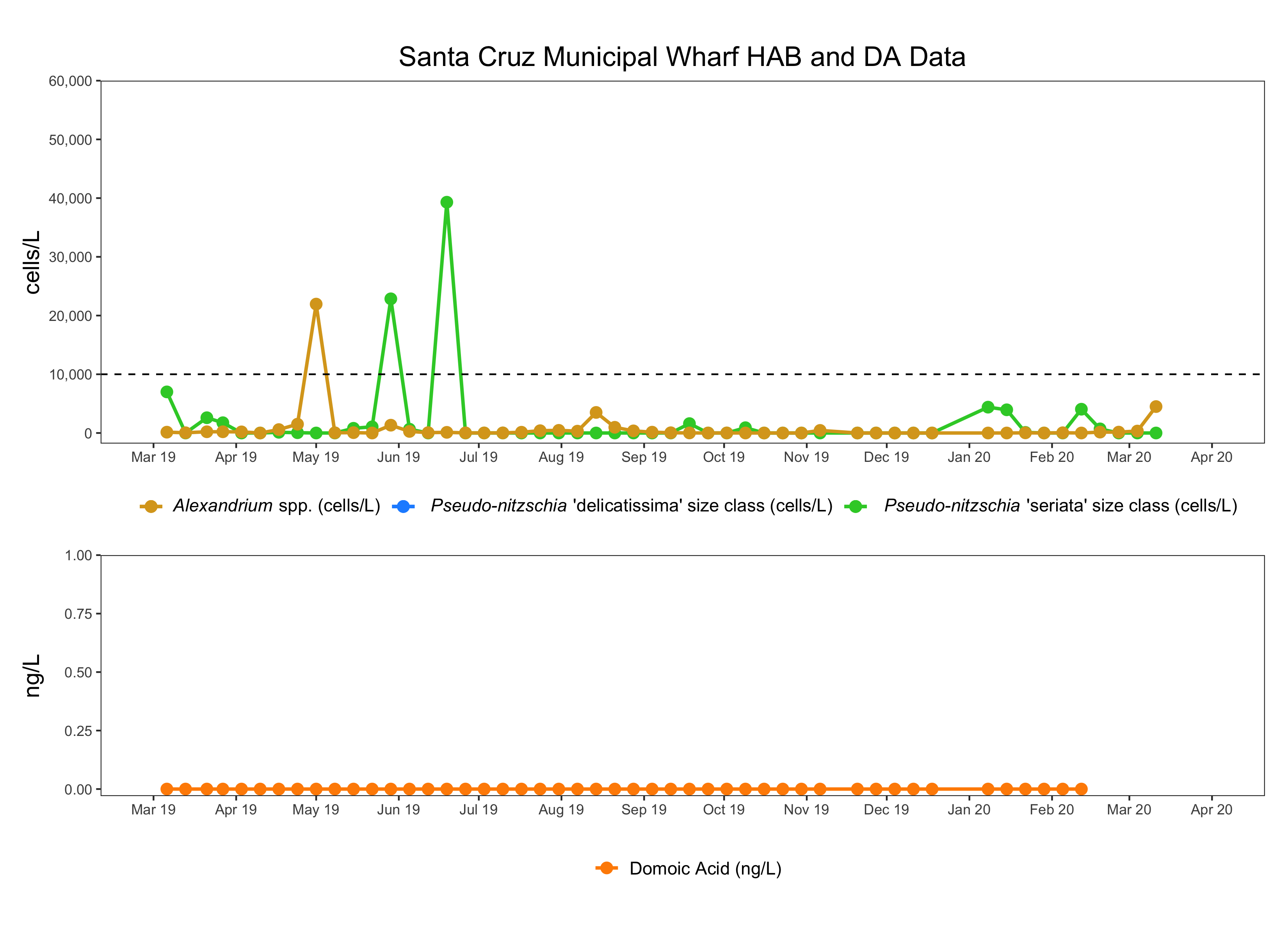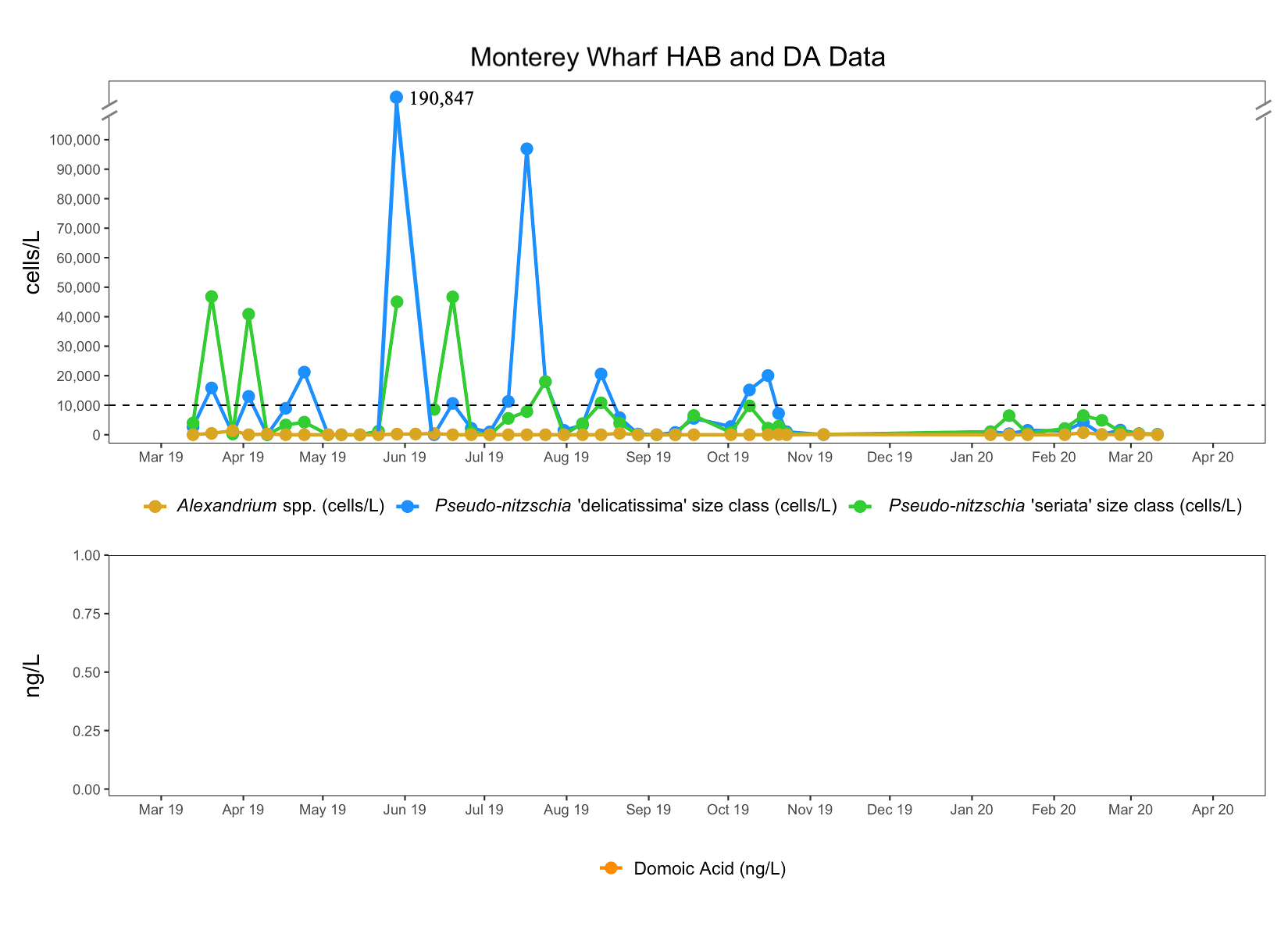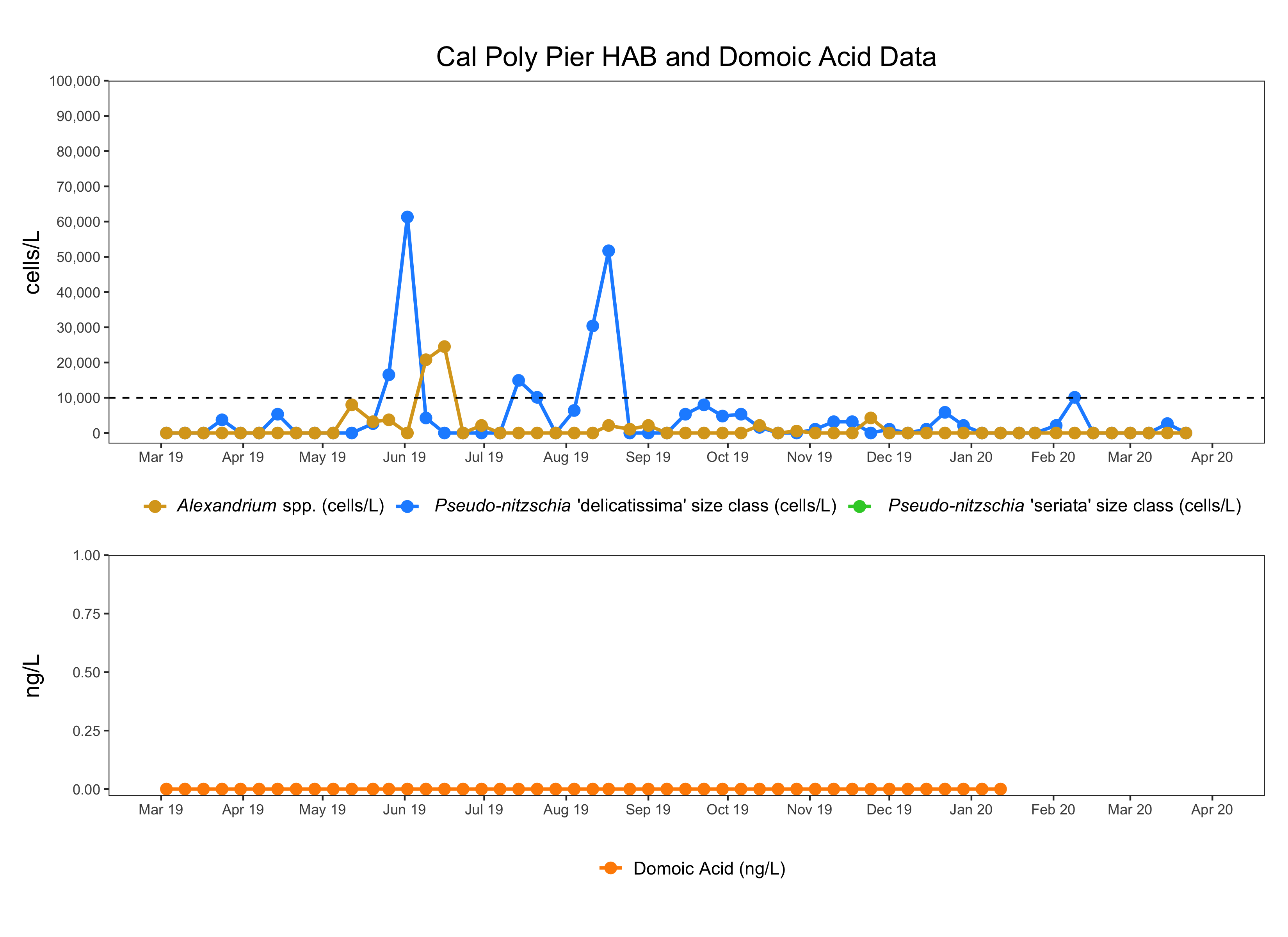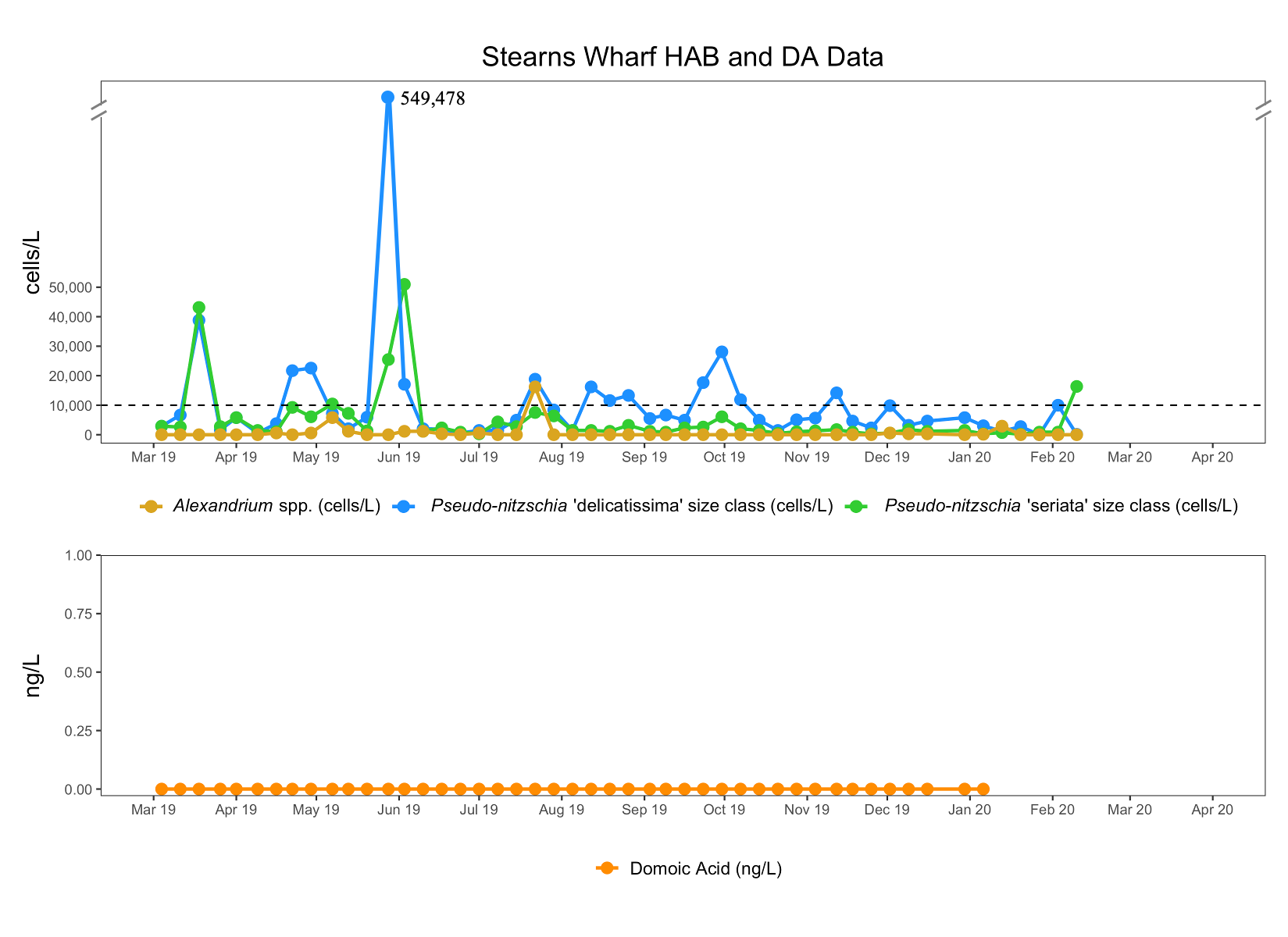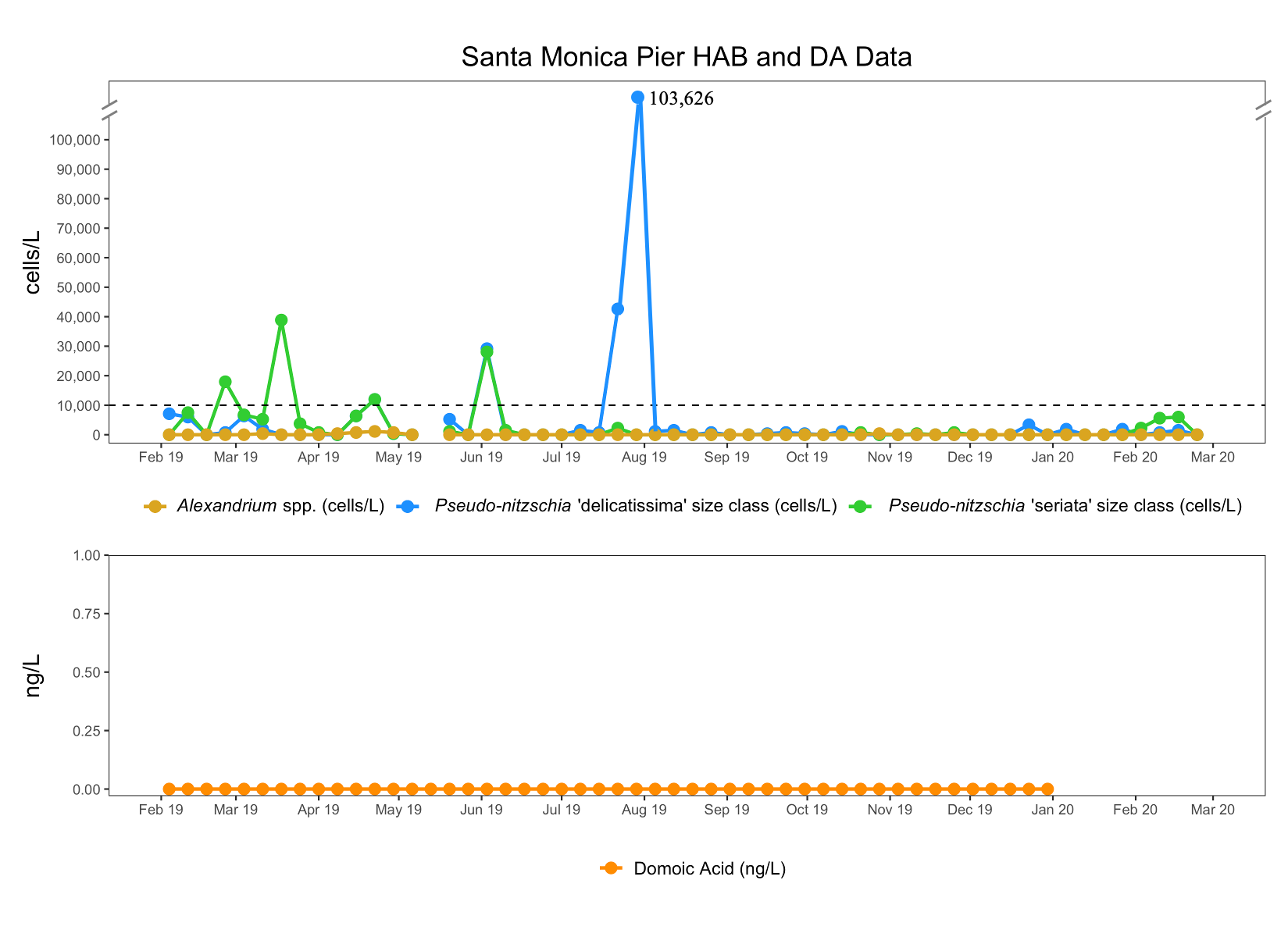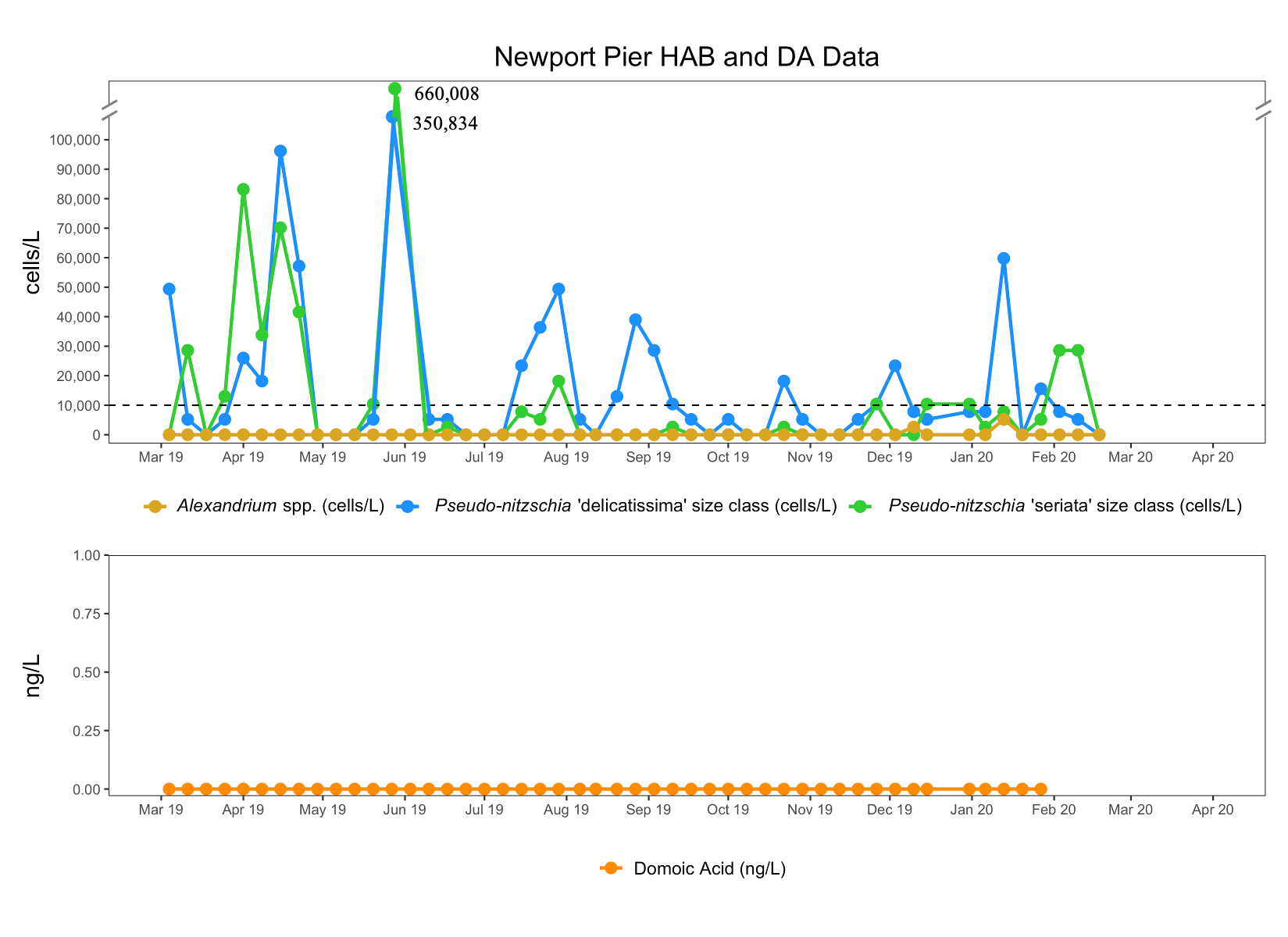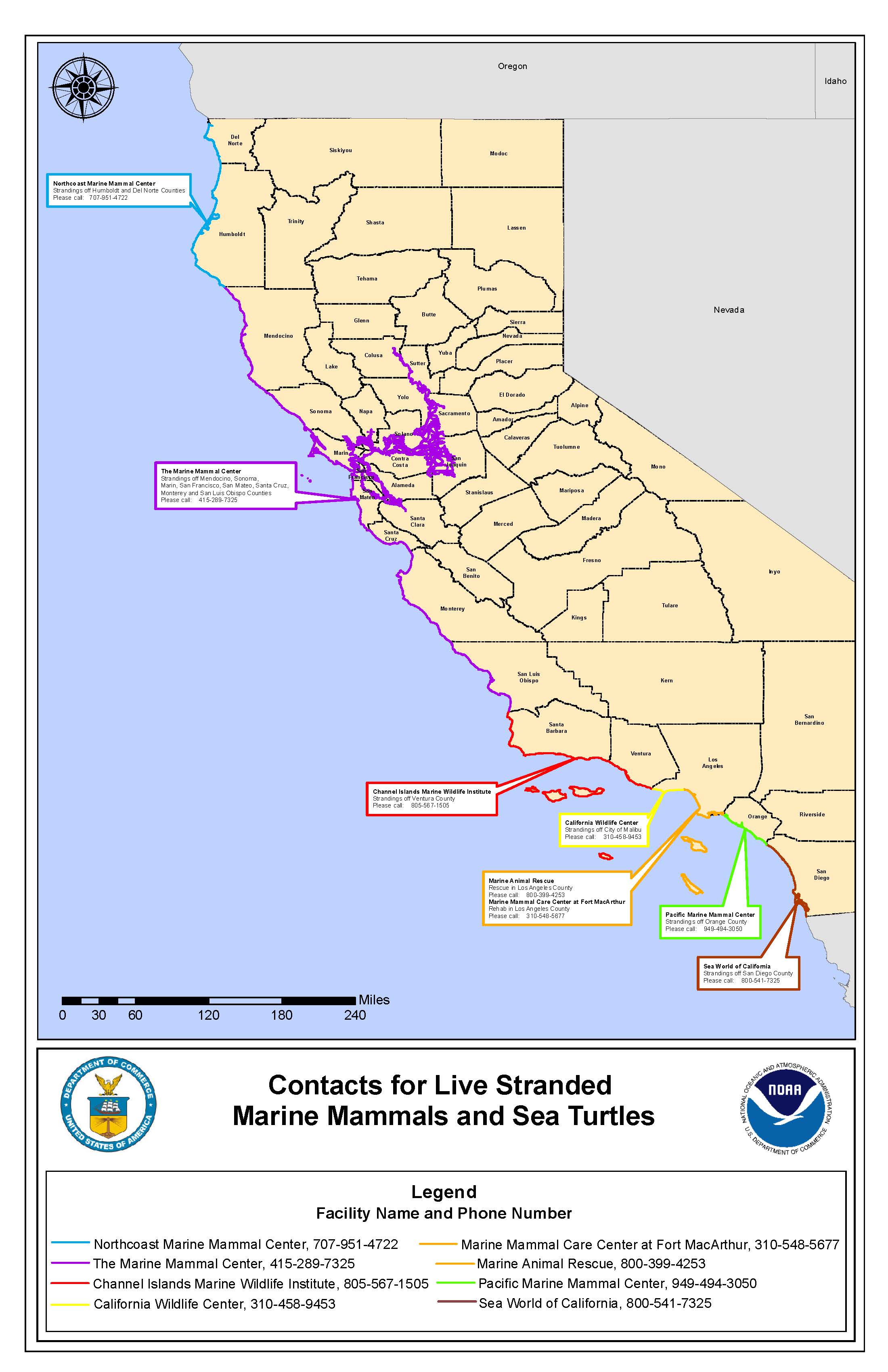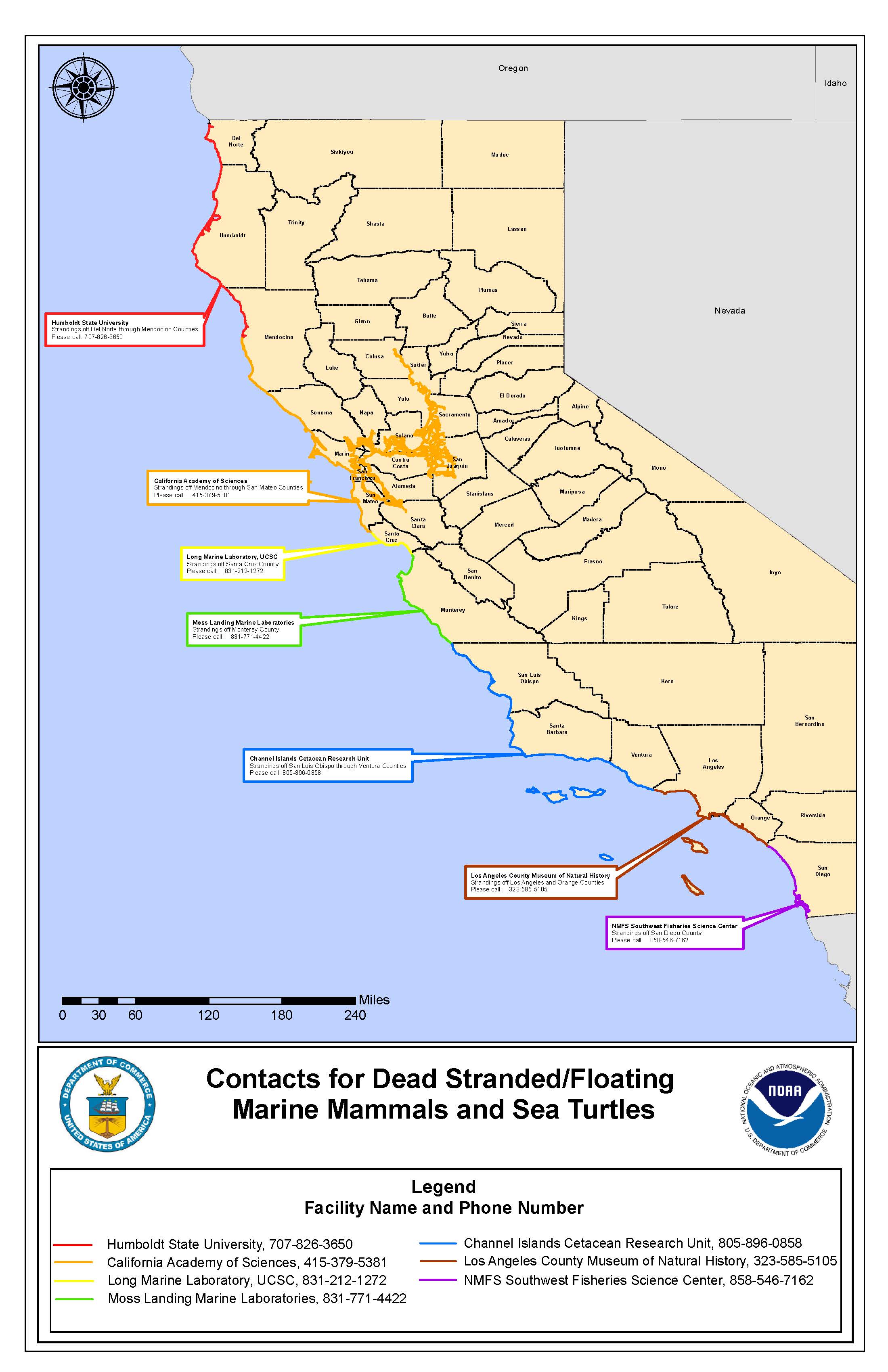Be sure to also read the special Red Tide Bulletin: Spring 2020
Pseudo-nitzschia - C-HARM tells us where conditions are suitable for species of the diatom Pseudo-nitzschia spp. (all size classes) to grow well and where they might be more likely to produce domoic acid (DA). Predicted suitable habitat for Pseudo-nitzschia spp. was spread around throughout coastal California in March, much like in previous months, although everywhere the probability tended to hover around 50% in the most nearshore zone and was often even lower in the Southern California Bight, except for the Santa Barbara Channel. Beyond the nearshore local minimum zone, a robust crop of Pseudo-nitzschia biomass was predicted for a coastal swath from Santa Barbara to Eureka, often only out to 100 or 200 hundred kilometers offshore. Most of the activity for particulate DA (pDA) was predicted for the regions north of Monterey Bay, where probabilities of a pDA event were high (well above 70%) throughout most of the month. Interestingly, local minima persisted with some temporal variability for central CA south of Monterey Bay, although the region around Pt. Conception and in the more offshore zone of the Southern California Bight was predicted to have higher pDA probabilities from the middle of the March onward. In contrast, C-HARM really highlighted the entire coast north of San Francisco as a high probability (typically above 70%) region for high cellular DA (cDA) levels with a broad offshore extent, similar to February, although with much less activity projected for the central coast. Unlike February, cDA probabilities were generally low (50% or lower) for the entire Southern California Bight in March. A few patches of high cDA probability blipped on and off far offshore within the SCB, perhaps indicative of offshore eddy activity.
As a possible validation of where offshore DA is high, we like to look at marine mammal strandings. The only two potential DA toxicosis cases recorded during this time of highly reduced beach activity and monitoring were in Mendocino County and Los Angeles County. This is consistent with high pDA and cDA probabilities throughout Feb and March for waters offshore Mendocino and is consistent with the periodically high pDA probabilities noted for the LA area. While cDA probabilities were mostly low for the LA area in March, they were high in February. Given that the animal stranded March 1, February conditions are more relevant.
In comparison with the Harmful Algal Bloom Monitoring and Alert Program (HABMAP) measurements where we have March data currently available, the only sites with bloom levels of Pseudo-nitzscha (i.e. 10,000 cells/L or more) were in the Southern California Bight (Scripps Pier). The larger, more toxigenic "seriata" size class of Pseudo-nitzschia hit bloom levels in late February at Stearns Wharf (Santa Barbara) and for late Feb and early March at Newport Beach Pier (Orange County). Note that samples were not collected and/or reported for Stearns Wharf and Newport Beach Pier in March due to Covid-19 restrictions which limited comparisons of these sites to the March CHARM outputs. Sampling activities were able to continue, to varying extents, at Scripps Pier and Santa Monica Pier in March. The less toxigenic "deli" size class hit bloom levels at Scripps Pier in early March, while the larger size class only approached bloom levels at Scripps Pier and at Santa Monica Pier. This is consistent with C-HARM in that these piers lie within zones of high Pseudo-nitzschia bloom and pDA event probability. Piers within other regions highlighted by C-HARM as more consistent hot spots, however, did not experience bloom-level Pseudo-nitzschia spp. abundances, such as Monterey Bay/Santa Cruz or Cal Poly. No DA data are yet available from March given restrictions put on labs during the COVID-19 closures.
CDPH recorded Pseudo-nitzschia "seriata" at most of the sites they sampled. Their highest relative abundance of Pseudo-nitzschia "seriata" was found near Pacifica Pier (San Mateo County) on March 15th. The closest HABMAP sampling to this site would be Santa Cruz Wharf observed at the last sampling event on March 11th prior to suspending sampling activities to comply with shelter in place orders.
Alexandrium - HABMAP sampling noted a small uptick in Alexandrium spp. presence at Santa Cruz Wharf, while CDPH also noted the presence at nine sites, all at very low percent composition (less than 2% composition).
**Please note that HABMAP sampling, CDPH sampling and marine mammal rescues have been greatly reduced in response to COVID-19 safety measures.
**HABMAP sampling at has been suspended since March 19th in accordance with the Governor's stay at home order to protect the health and well-being of all Californians and to help slow the spread of COVID-19. Cal Poly and Scripps received an exception to continue collecting water samples for the State and are taking the necessary safety measures to protect field personnel. The water samples are being preserved for future analysis by the Caron or Kudela Labs for domoic acid and Brzezinski/UCSB Marine Analytical Labs for macronutrients when it is safe for lab personnel to do so.**
Note that data for some stations are not shown because they are not yet recorded in the public HABMAP archive.
Differentiating Pseudo-nitzschia species by light microscopy is difficult. For this reason, Pseudo-nitzschia "seriata" does not refer to an actual species but rather the larger size class of Pseudo-nitzschia, which is generally a more toxigenic group of species. Alternatively, Pseudo-nitzschia "delicatissima" refers to the smaller size class that is generally non-toxigenic. The dashed line on the plots demarcates the 10,000 cells/L "bloom" threshold designated here for Pseudo-nitzschia populations only.
More information and data visualizations on the statewide HAB network and forecasting system can be found here and on the SCCOOS HABMAP page.
Santa Cruz Wharf
Water samples were collected at Santa Cruz Wharf two times in the month of March. Molecular probes for toxigenic Pseudo-nitzschia in the "seriata" class are conducted for this site, but was not detected in the samples. Alexandrium spp. were detected on March 4th and 11th. Domoic acid results are not yet available for March. Santa Cruz Wharf does not count for Pseudo-nitzschia delicatissima group.
The Santa Cruz Wharf shore station is supported by CeNCOOS PI Raphael Kudela at UCSC.
Monterey Wharf
Water samples were collected at Monterey Wharf two times in the month of March. Pseudo-nitzschia seriata and delicatissima group were detected below bloom levels on March 4th and 11th and Alexandrium spp. were detected at low levels on March 4th. Domoic acid results are not yet available for March.
Monterey Wharf shore station is supported by CeNCOOS PI's Raphael Kudela at USCS and Jason Smith and Moss Landing Marine Labs.
Cal Poly Pier
Water samples at Cal Poly Pier were collected three times in the month of March. Pseudo-nitzschia delicatissima group was detected below bloom levels on March 15th and Alexandrium spp. were not detected in any of the samples. Domoic acid results are not yet available for March.
Cal Poly Pier shore station is supported by SCCOOS PI Ryan Walter and Ally Pasulka at Cal Poly.
Stearns Wharf
Water samples were not collected at Stearns Wharf in the month of March.
Stearns Wharf is supported by SCCOOS PI Mark Brzezinski and Libe Washburn at UCSB.
Santa Monica Pier
Water samples were collected at Santa Monica Pier three times in the month of March. Pseudo-nitzschia seriata was detected below bloom levels on March 2nd and 9th. Pseudo-nitzschia delicatissima group and Alexandrium spp. were not detected in any of the samples and domoic acid results are not yet available for March.
Santa Monica Pier shore station is supported by SCCOOS PI Rebecca Shipe at UCLA.
Newport Beach Pier
Water samples were not collected at Newport Beach Pier in the month of March.
Newport Beach Pier is supported by SCCOOS PI David Caron at USC.
Scripps Pier
Water samples were collected four times at Scripps Pier in the month of March. On March 2nd Pseudo-nitzschia delicatissima group was detected above bloom levels and Pseudo-nitzschia seriata group was detected below bloom levels. Alexandrium spp. were not detected in any of the water samples and domoic acid results are not yet available for March.
Scripps Pier is supported by SCCOOS and PIs Melissa Carter and Clarissa Anderson at UCSD.
CDPH observations for Pseudo-nitzschia spp. and Alexandrium spp.
Please note CDPH recently moved to only reporting Pseudo-nitzschia of the seriata complex and not all Pseudo-nitzschia spp. as previously provided.
From 1-31 March 2020, water samples were collected by volunteers and sent to the California Department of Public Health (CDPH) for analysis. Pseudo-nitzschia seriata group were detected in 55 of the 58 samples. Pseudo-nitzschia seriata was detected at "Common" density levels (using CDPH relative abundance index) on March 15th at Pacifica Pier in San Mateo County (10% composition). Alexandrium spp. were detected in 9 of the 58 samples in the month of March at low density levels (<2% composition).
You can view an interactive map and data table of CDPH data from January 2019 to present developed by SCCOOS below or you can also view CDPH weekly map layers of Pseudo-nitzschia and Alexandrium spp. here.
Data are provided by the California Department of Public Health, Environmental Management Branch.
CDPH and OEHHA Health Advisories
California Department of Public Health (CDPH) released no health advisories for fisheries and aquaculture in the month of February 2020. For the latest closures and updates, please visit the CDPH Health Advisories page as a central location of information related to CDPH and/or OEHHA health advisories.
On July 30, 2019 the Office of Environmental Health Hazard Assessment (OEHHA) hosted the Domoic Acid Webinar: Research on Effects of Repeat Low-Level Exposures and Its Implications for Human Toxicity. The recorded webinar can be found here.
Domoic acid (DA) is a potent neurotoxin produced by some diatom species of the genus Pseudo-nitzschia. Species exposed to DA can result in seizures, epilepsy, cardiomyopathy, and death depending upon the ingested dose. DA toxicosis commonly occurs in California Sea Lions (Zalophus californianus), presumably due to a combination of foraging behavior and seasonal movements. The Marine Mammal Center (TMMC), the California Wildlife Center (CWC), the Marine Mammal Care Center Los Angeles (MMCC-LA), Marine Animal Rescue (MAR), the Pacific Marine Mammal Center (PMMC), and SeaWorld act like an emergency room by working to rescue and rehabilitate sick and injured marine mammals, seabirds, and sea turtles.
In response to COVID-19 safety measures the marine mammal rescues have been greatly reduced.
Among the six rehabilitation centers we received data for in the month of March a total of 2 marine mammal strandings presented with symptoms of domoic acid toxicosis.
The Marine Animal Rescue, Pacific Marine Mammal Center and Sea World did not record any strandings due to suspected domoic acid in March 2020.
March strandings due to suspected DA toxicosis occurred in the following counties:
Mendocino County (TMMC)
- March 6th, yearling, female, California Sea Lion
Los Angeles County (MMCC-LA)
- March 1st, yearling, female, California Sea Lion
At this time we do not have data from the North Coast Marine Mammal Center or the Channel Islands Marine Wildlife Institute.
Please subscribe to CA HAB Bulletin listserv to receive the monthly CA HAB Bulletin.

